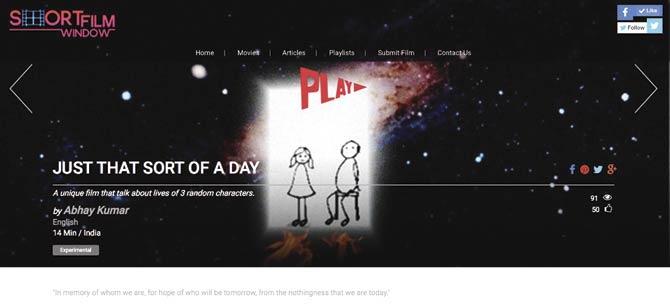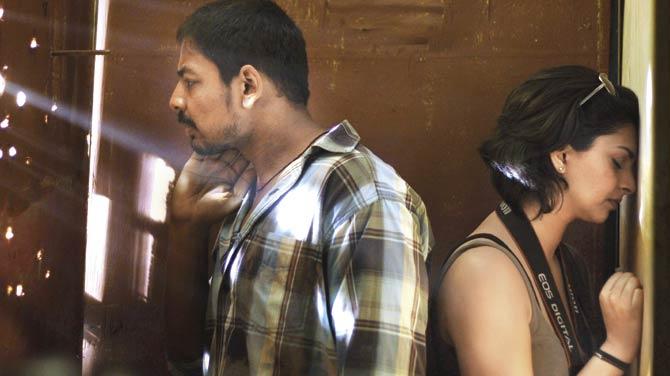Short films have found a fresh lease of life on the Internet and social media. Multiple video sharing websites have now enabled filmmakers to reach out to a huge audience and even earn money in some cases

![]() Short films have come a long way. This genre, once treated as a glimpse of the body of work of a master, an agenda film or something created by film students for festivals, has embarked on a popular and possibly commercial journey on the Internet.
Short films have come a long way. This genre, once treated as a glimpse of the body of work of a master, an agenda film or something created by film students for festivals, has embarked on a popular and possibly commercial journey on the Internet.
ADVERTISEMENT

A still from the film, Time Machine, directed by Arati Kadav and produced by Zain Matcheswalla (3,587 views)
Filmmakers are now being able to reach out to a large audience in a matter of days and sometimes even earning money from Internet viewership. But the tools of this change, that the films are riding on, are mostly unknown though widely used. This curious world is the dynamic space of web partnership, promotion and hosting of such films on the Internet.

A still from the film, I Love You Too, directed by Aadish Keluskar, which received 1,68,046 views on YouTube
Rewind the reel
To understand this, one needs to go back a few years, when Google announced its YouTube Partner Program in India in 2011, which enabled people, who made regular and popular uploads to the site, to generate revenue from their videos.

Screen shot of the website ShortFilm Window
Using this opportunity, Pocket Films decided to launch its YouTube channel and became one of the first channels in India focused on short films. Other initiatives like ShortFilmWindow, HumaraMovie, Jamuura and Terribly Tiny Talkies all focusing on short films, followed.

The website, ShortFilmWindow, featuring the film, Just That Sort Of A Day, by Abhay Kumar
According to Satya Raghavan, Head of YouTube Content Partnerships India, Short films have always been part of YouTube’s repository of content as creators can get access to a global user base and the format of short films suits the web as a platform. And As the Internet user base evolved in India, short films are doing extremely well.

A still from the movie, Fearless, produced by Rockstar Studios
Sameer Mody, the founder and CEO of Pocket Films, says that he could see a gap in the system between filmmakers and the market and was toying with the idea from 2008-09. “I saw how many filmmakers had no reliable way to showcase their work to a large audience.

Logo of the website ShortFilmWindow
At that time, YouTube was entering India and we grabbed the opportunity. We are among the first few partners for YouTube in India," he explains. The website’s short film channel has over 1,80,000 subscribers and more than 100 million views generated from over 3,000 videos.
From the other network of channels, they have over 5,00,000 subscribers and 350 million views. Among these, a lot of films have over 50,000 views, some over a hundred thousand views and some are locked and can be watched after paying a nominal amount.
Like the award-winning film, Smothered, can be watched after paying Rs 25. But Mody is aware that views alone cannot determine quality. And he thinks it is important to provide space for quality too. “There are many good films, which haven’t yet got due recognition. It’s the same with feature films where a good Indie film will find it difficult to get viewership when compared to popular films,” he shares.
Arati Kadav, the founder of ShortFilmWindow, a website that hosts short films from around the world, considers the Internet a more 'farm-to-fork situation', where filmmakers reach their audience directly. "YouTube is a great starting point for modern-day content creators as firstly it is a great player and secondly, it has its ad network that helps filmmakers monetise the content. For startups like ShortFilmWindow, it serves as a great backend as making a video player from scratch is expensive. So it becomes an enabler," she says.
Social media saviour
And filmmakers agree. Bhargav Saikia, whose film, Awakenings, is receiving critical acclaim, considers social media an extremely powerful tool for independent filmmakers when it comes to generating a buzz around a project.
“With no lavish budget to spend on marketing, indie filmmakers can use tools like Facebook ads and promoted tweets to effectively reach their target audience. I have regularly used Facebook ads to promote both, my feature film, Kaafiron Ki Namaaz, and my horror short film, Awakenings,” he says.
Others like Aaadish Kurleskar whose film, I Love You Too, shared by Humaramovie has 1,67,938 views on YouTube, considers social media the best possible way now to reach out. “It has given the filmmaker the freedom to go beyond the agenda-based or social message-based films to just tell a story,” he says.
Pramod Sanghi, who received critical acclaim for his film Fearless and is crowdfunding his new film Pinjra, feels that the Internet has given the freedom to filmmakers to venture into areas like science fiction or horror, skipping the skeptical big producers.
But for some new filmmakers, this world is still a hazy one, if not confusing. Aditya Nair, an advertising professional based in Mumbai, who has made two short films, says that he is aware that some films have gone viral and made money through these channels but he is not aware how. “I have mostly put up films on my own initiative, and it did not generate too many views,” he says.
The show must go on Kadav, however, considers the process to enter a film in her website simple. “ShortFilmWindow.com is like an online mini-theatre in your computer for best well-made short films. The site has a simple Submit Film form, where you submit your film and we contact you.
Alternatively, people email us (shortfilmwindow@gmail.com) with their films. For every film, we decide a release week and work with filmmakers to create publicity material. Our motto is to treat your short film release as your feature film release," she says. The other websites claim that it is easy too. Archana Borhade, whose film Bhopal Diaries 2012 won a Special Mention at the Manhattan Global Shorts festival, explains the process.
"Whenever Pocket Films acquires short films from filmmakers like me, we enter into revenue sharing agreement with them by virtue of which we receive periodic payments based on the views that our films get. So not only do our films get a wider audience, but we also get a decent remuneration for making those films," she explains.
 Subscribe today by clicking the link and stay updated with the latest news!" Click here!
Subscribe today by clicking the link and stay updated with the latest news!" Click here!






